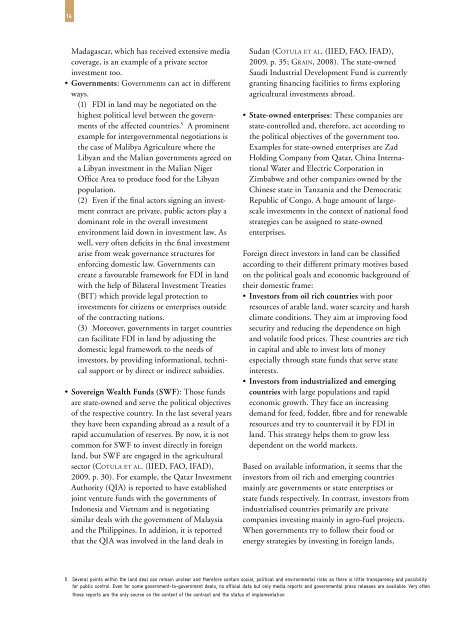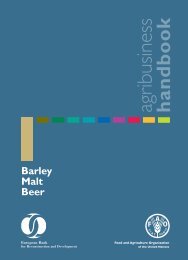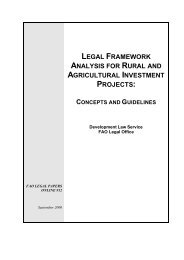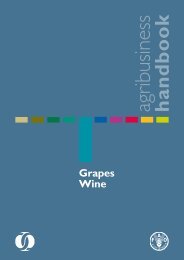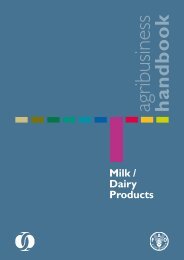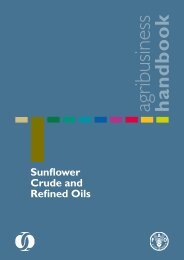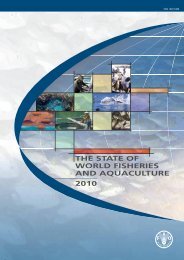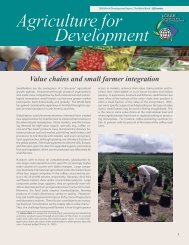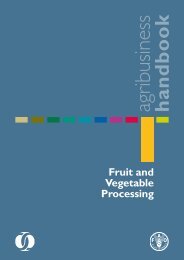Foreign Direct Investment (FDI) in Land in developing countries
Foreign Direct Investment (FDI) in Land in developing countries
Foreign Direct Investment (FDI) in Land in developing countries
- No tags were found...
Create successful ePaper yourself
Turn your PDF publications into a flip-book with our unique Google optimized e-Paper software.
14Madagascar, which has received extensive mediacoverage, is an example of a private sector<strong>in</strong>vestment too.• Governments: Governments can act <strong>in</strong> differentways.(1) <strong>FDI</strong> <strong>in</strong> land may be negotiated on thehighest political level between the governmentsof the affected <strong>countries</strong>. 5 A prom<strong>in</strong>entexample for <strong>in</strong>tergovernmental negotiations isthe case of Malibya Agriculture where theLibyan and the Malian governments agreed ona Libyan <strong>in</strong>vestment <strong>in</strong> the Malian NigerOffice Area to produce food for the Libyanpopulation.(2) Even if the f<strong>in</strong>al actors sign<strong>in</strong>g an <strong>in</strong>vestmentcontract are private, public actors play adom<strong>in</strong>ant role <strong>in</strong> the overall <strong>in</strong>vestmentenvironment laid down <strong>in</strong> <strong>in</strong>vestment law. Aswell, very often deficits <strong>in</strong> the f<strong>in</strong>al <strong>in</strong>vestmentarise from weak governance structures forenforc<strong>in</strong>g domestic law. Governments cancreate a favourable framework for <strong>FDI</strong> <strong>in</strong> landwith the help of Bilateral <strong>Investment</strong> Treaties(BIT) which provide legal protection to<strong>in</strong>vestments for citizens or enterprises outsideof the contract<strong>in</strong>g nations.(3) Moreover, governments <strong>in</strong> target <strong>countries</strong>can facilitate <strong>FDI</strong> <strong>in</strong> land by adjust<strong>in</strong>g thedomestic legal framework to the needs of<strong>in</strong>vestors, by provid<strong>in</strong>g <strong>in</strong>formational, technicalsupport or by direct or <strong>in</strong>direct subsidies.• Sovereign Wealth Funds (SWF): Those fundsare state-owned and serve the political objectivesof the respective country. In the last several yearsthey have been expand<strong>in</strong>g abroad as a result of arapid accumulation of reserves. By now, it is notcommon for SWF to <strong>in</strong>vest directly <strong>in</strong> foreignland, but SWF are engaged <strong>in</strong> the agriculturalsector (Cotula et al. (IIED, FAO, IFAD),2009, p. 30). For example, the Qatar <strong>Investment</strong>Authority (QIA) is reported to have establishedjo<strong>in</strong>t venture funds with the governments ofIndonesia and Vietnam and is negotiat<strong>in</strong>gsimilar deals with the government of Malaysiaand the Philipp<strong>in</strong>es. In addition, it is reportedthat the QIA was <strong>in</strong>volved <strong>in</strong> the land deals <strong>in</strong>Sudan (Cotula et al. (IIED, FAO, IFAD),2009, p. 35; Gra<strong>in</strong>, 2008). The state-ownedSaudi Industrial Development Fund is currentlygrant<strong>in</strong>g f<strong>in</strong>anc<strong>in</strong>g facilities to firms explor<strong>in</strong>gagricultural <strong>in</strong>vestments abroad.• State-owned enterprises: These companies arestate-controlled and, therefore, act accord<strong>in</strong>g tothe political objectives of the government too.Examples for state-owned enterprises are ZadHold<strong>in</strong>g Company from Qatar, Ch<strong>in</strong>a InternationalWater and Electric Corporation <strong>in</strong>Zimbabwe and other companies owned by theCh<strong>in</strong>ese state <strong>in</strong> Tanzania and the DemocraticRepublic of Congo. A huge amount of largescale<strong>in</strong>vestments <strong>in</strong> the context of national foodstrategies can be assigned to state-ownedenterprises.<strong>Foreign</strong> direct <strong>in</strong>vestors <strong>in</strong> land can be classifiedaccord<strong>in</strong>g to their different primary motives basedon the political goals and economic background oftheir domestic frame:• Investors from oil rich <strong>countries</strong> with poorresources of arable land, water scarcity and harshclimate conditions. They aim at improv<strong>in</strong>g foodsecurity and reduc<strong>in</strong>g the dependence on highand volatile food prices. These <strong>countries</strong> are rich<strong>in</strong> capital and able to <strong>in</strong>vest lots of moneyespecially through state funds that serve state<strong>in</strong>terests.• Investors from <strong>in</strong>dustrialized and emerg<strong>in</strong>g<strong>countries</strong> with large populations and rapideconomic growth. They face an <strong>in</strong>creas<strong>in</strong>gdemand for feed, fodder, fibre and for renewableresources and try to countervail it by <strong>FDI</strong> <strong>in</strong>land. This strategy helps them to grow lessdependent on the world markets.Based on available <strong>in</strong>formation, it seems that the<strong>in</strong>vestors from oil rich and emerg<strong>in</strong>g <strong>countries</strong>ma<strong>in</strong>ly are governments or state enterprises orstate funds respectively. In contrast, <strong>in</strong>vestors from<strong>in</strong>dustrialised <strong>countries</strong> primarily are privatecompanies <strong>in</strong>vest<strong>in</strong>g ma<strong>in</strong>ly <strong>in</strong> agro-fuel projects.When governments try to follow their food orenergy strategies by <strong>in</strong>vest<strong>in</strong>g <strong>in</strong> foreign lands,5 Several po<strong>in</strong>ts with<strong>in</strong> the land deal can rema<strong>in</strong> unclear and therefore conta<strong>in</strong> social, political and environmental risks as there is little transparency and possibilityfor public control. Even for some government-to-government deals, no official data but only media reports and governmental press releases are available. Very oftenthose reports are the only source on the content of the contract and the status of implementation.


